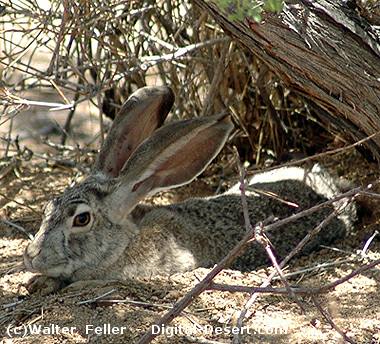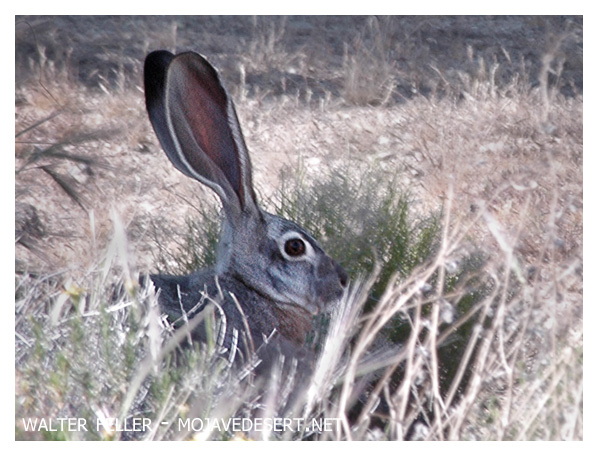--
Denizens
Black-tailed Hare
(Lepus californicus deserticola) Among the smaller animal folk of the arid
Southwest, the black-tailed hare or desert jack
rabbit, is the paragon of racers. His only rival
is the desert sand-lapper, that swift-footed
lizard that seems to run over ground as birds
fly through air. The coyote often attempts to
outrun the hare and sometimes overtakes him,
but more often this green-eyed rogue catches
his "jack" through strategy rather than by
mere swiftness of foot. The coyote is wise and
sagacious enough to know that if two of his kind
will cooperate in the hunt they can take advantage
of the rabbit's tacking habits and get
him without long chases. The first one chases
up the hare, and the second places himself in
such a position that when the rabbit changes
his course he runs square into the jaws of the
waiting coyote.
Among the smaller animal folk of the arid
Southwest, the black-tailed hare or desert jack
rabbit, is the paragon of racers. His only rival
is the desert sand-lapper, that swift-footed
lizard that seems to run over ground as birds
fly through air. The coyote often attempts to
outrun the hare and sometimes overtakes him,
but more often this green-eyed rogue catches
his "jack" through strategy rather than by
mere swiftness of foot. The coyote is wise and
sagacious enough to know that if two of his kind
will cooperate in the hunt they can take advantage
of the rabbit's tacking habits and get
him without long chases. The first one chases
up the hare, and the second places himself in
such a position that when the rabbit changes
his course he runs square into the jaws of the
waiting coyote.
Yesterday, while out with the donkeys to visit an old Indian cave, I was suddenly startled by a jack rabbit who ran across the trail. His eyes were wild with terror. Hardly had he passed when hot upon his heels came a murderbent coyote with greedy jaws gaping wide ready to grasp his victim. So close was he on the chase that the two or three forward steps which I took, between the time I saw the rabbit and noticed the coyote, placed me between the two, and the coyote found it difficult to stop short enough to prevent himself from dashing right into me. As it was, he stumbled and almost threw himself over backwards in the efforts to slacken his pace. As soon as he recovered himself, he sneakingly ran off to one side, sat down on his tail, and, with his tongue hanging from between his panting jaws, divided his attention between me and the escaping rabbit, looking first reproachfully and scornfully at me and then curiously, longingly, and with comical regret at his departing dinner. He was, no doubt, wondering, like men who have suddenly lost long-sought fortunes, how it had all happened so quickly. The rabbit was fully aware of his new chance for life and made away as fast as his strong, lanky limbs would carry him. Had I not been there and intercepted the coyote, another instant would have witnessed the poor rabbit being torn to shreds by those cruel canine teeth.
I have often wondered how it would seem to be thus called upon to flee for one's life at a moment's notice with the unhappy and horrible prospect of being eaten alive if one's prowess as a runner was not equal to the exigency. There is no doubt but that not only rabbits but nearly all smaller mammals are almost daily called upon to meet just such issues. How hard their lot must be in comparison with that of the super-mammal, man, who through his wisdom and invention has found almost complete freedom from such dangers! Rabbits seem to have about the hardest lot of all the small mammals that roam the fields; for the number of their natural enemies is almost legion. Owls, hawks, snakes, coyotes, wild cats, golden eagles, and man, all crave their tender flesh and thirst for their sweet, warm blood ; and were it not for the extraordinary fecundity of these rodents they would long ago have become extinct. Nature, solicitous for the rabbits' preservation, or else desirous that her other wild children should have plenty of sport and good food, has decreed that there should always be many young to replace the old ones who have fallen prey to the gunners, rapacious birds and beasts.
This long-eared rodent of our sketch is exceptionally easy to distinguish from other rabbits of his range by the black tail which he carries compressed against his rump. His light weight, thin body, and exceptionally long legs are characters which separate him from the short-bodied bunnies or cottontails.
When he is hopping about feeding or traveling at ordinary speeds, the long membraneous ears are carried erect, but when the hare is traveling at high speed the air pressure induced forces them to lie back. The black-tailed rabbit evidently realizes what conspicuous appendages his jet-tipped ears are, and when trying to conceal himself in the open he crouches low on the sand and lays the ears well back. As soon as he thinks it safe he gets into the brush, rises up on his haunches, and without fear of detection erects his ears and tests every wave of sound that comes his way.

These rabbits are out foraging both during the day and at night, but they are the more active in the dark. Much of the time during the day they remain hidden in pocket-like shelters made in the brush. These "forms," as they are called, are about the rabbits* only protection against bad weather, and were it not for their heavy, furry winter coats they would spend many days in discomfort. The cottontails are wise enough to seek shelter in holes.
When the rabbits go foraging, they are not fastidious eaters. The bitter-barked creosote bush and the Bigelow's cactus are among the few plants of the desert immune from their attack. Practically all other trees, shrubs, and herbs are subject to their nibbles. Even the greater number of cactuses with their sharp spines are robbed of their juicy outer parts. Barrel cactuses, those spine-protected natural reservoirs of the desert, are especially sought out. How the tender rabbit noses are able with impunity to be thrust in between the rigid, thick-set spines is a mystery that is still to be explained. I have often found on the dry, rocky mesas, great numbers of the bisnagas, or barrel cactuses, completely girdled, the pulp-meat having been gouged out an inch of more deep all around. Around the base of each was a ring of excreta, leaving no doubt as to who the nibblers were. The desert rabbits seldom drink, but depend almost wholly for water on such foods. During the summer months their body excretions are reduced to the lowest minimum, and even though they can get to succulent food supplies only occasionally, they suffer little from thirst. A rabbit never perspires in the ordinary sense of the term in so far as I can learn. The sweat glands which function actively are very few and are probably confined to small areas of the skin.
The young come in April or May — born with eyes wide open and with bodies well clothed with hair. No days of helplessness are waiting for them. They stand ready to be off almost as soon as they see the world. Within a few weeks after birth these little fellows are showing much independence, getting around at a lively clip and indiscreetly giving hostages to fortune by exposing themselves to every enemy that may lie in wait for them.
At times rabbits become so plentiful that they are seen almost everywhere in the open country, and then after this there may come years when they seem to have in large part disappeared. Many old prospectors and ranchmen will tell you that this is because food is scarce and that the rabbits have gone to better feeding- grounds. This is an error. While food deficiency may have something to do with the ability of great numbers of rabbits to subsist in any region, yet their scarcity at certain periods cannot be accounted for wholly on this basis. These lagomorphs are subject to several contagious maladies which at times so reduce their numbers that it would seem there were scarcely enough healthy ones left to replenish their kind. But those that survive manage to repopulate the fields in a remarkably short time, and the ranchers are all too soon complaining about "too many jack rabbits" again.
The water blisters often found on hares are due to the presence of the larval form of a tapeworm. The late Dr. Katherlne Brandegee worked out the life-history of this parasite, and I give her words concerning it:
"Swellings known to hunters as 'water boils* are found in a very considerable proportion of hares. So far as I have observed, they do not occur in the smaller species, the brush rabbit and the cottontail, of which I have examined several hundred specimens. .'. . "Tapeworms are exceedingly common, most animals harboring one or more, either in the perfect or larval state, but they are rare in the reptiles. Their life-history is tolerably well known; those which belong properly to the carnivora pass their larval stage in the flesh of some herbivorous animal which is the natural prey to its future host.
"The natural hosts of the ccenurus [tapeworm] of the hare are probably the dog and the wolf. A hare badly infested with ccenurus becomes swollen and deformed, and as the loins and thighs are attacked by preference his powers of locomotion are seriously impaired. In this condition he falls an easy prey to his hereditary foe, the coyote.
"The coyote swallows not only the hare, but its ten thousand contained larvae, a circumstance which would undoubtedly give his victim a feeling of malicious joy, if he were in a condition to know anything at all about it. The larvae are set free in the stomach of the coyote by digestion of the vesicle that surrounds them, and a certain proportion succeed in attaching themselves by their hooks and suckers to the walls of the small intestine; fortunately only a very small proportion. Their way is beset with dangers, and their extraordinary fecundity is calculated in proportion to their chances of safety. The tapeworm is a colony of hermaphrodites, each joint of which is a sexually complete animal, male and female, containing thousands of eggs. It reaches maturity in about six weeks, after which period the lower joints, and numerous free eggs, are discharged at each evacuation and deposited upon the ground, weeds, or grass.
"The eggs are so small as to be quite invisible to the unaided eye, and being furnished with a thick envelope have considerable tenacity of life. The hare swallows the eggs, either by feeding upon the grass and weeds or by drinking from pools of water into which they have been washed. In the stomach the thick envelope is digested, the contained embryo is set free, and immediately starts for its predestined resting-place. This microscopic embryo is furnished with six booklets by means of which it penetrates the walls of the intestine and embeds itself in the muscular tissue. Here it ceases to move, its booklets fall off, and it slowly develops into a polycephalos [manyheaded] vesicle."
Black-tailed Jackrabbit
Young jackrabbits are born bright-eyed and active, and after only one month they can fend for themselves.